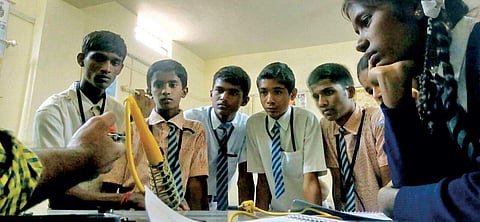

BENGALURU: With an aim to inculcate a love for both science and robotics, three college students from the city started Project NxG that has been made available to those children who otherwise would not have the opportunity to pursue science and robotics. Dheeraj Tiwari claims it all started when he, along with his friends Vinod Kumar and Vasanth Solomon met Ananya Rajgopal, the niece of Ashwin Naidu- an industrialist and their martial arts instructor.
“Ananya, has a patent under which she gives phased-out Lego robotic sets to underprivileged schools in the US, where she is based. We were inspired by that and wanted to do something similar here,” says Dheeraj. Thus, the idea to start Project NxG came to be. With a little help from Ashwin, their martial arts instructor-turned-mentor, the team of three had what they needed to kick-start the project. “He is an experienced industrialist. His own company manufactures robots and other equipment. So, he gave us crucial inputs during the creation of the curriculum and arranged for the initial round of funding to start work,” adds Dheeraj.
The team believes that automation is the future. “Anyone in the tech industry will tell you the same,” he goes on to add.The driving goal behind the project is to teach the basics of robotics to underprivileged children in the city. Working with government schools in Bengaluru, the team took their expertise to where it was needed most. “The idea here is to expose the children to the technology of the future by giving them a certain level of training,” says Dheeraj.
Challenges faced while reducing operating costs
However the trio faced several obstacles while introducing the subject in schools where a majority of the children come from low-income backgrounds. A major challenge the team faced was reducing costs, “we opted for locally and readily available electronic material and hardware to keep costs low,” says Dheeraj. The designing of the curriculum also took a certain amount of time to perfect. “At the outset, we teach them the basics of electronics and circuitry to help them gain an understanding of electricity and its properties. The course then goes on to cover projects with increasing complexity, finally teaching them to design an RC (remote controlled) car,” he adds.
Holding regular classes for the past one year, the three go to each school once a week to hold 1 to 2 hour after-school sessions. “We start with 8th and 9th standard students. But, we have been able to add 10th standard students to the sessions in some schools. The curriculum has been drawn out to fit a one year period,” he adds.
Talking to a few students from Domlur Government School, one can sense their excitement when they talk about robotics. “We had classes every Tuesday for a whole year. We had a lot of fun and we learnt about circuits and programming. In the end we made a remote controlled car,” says an excited 9th Standard student named Sunil. For John Paul, the classes made him realise that he wanted to pursue science in the future.
‘There is an uneven distribution of boys and girls’
While the boys seem to have taken to the classes with ease, a challenge the project faces is the lack of girls joining the sessions. Aruna KH, the principal of Kudlu government school blames it on the timings, “These classes are conducted after school and many stay far away. So the parents don’t want their girls to be returning home so late.,” she says. “But at the same time, we have a timetable to follow. We can’t conduct these classes during normal school hours,” she adds.
This is an issue that the team is trying to figure out. “To increase the participation of girl students in next batches we are trying to get female volunteers with whom the girls can get more comfortable with. We are also trying to convince the parents by personally speaking to them and to try and tweak the class timings so that the students won’t have to stay in late after school,” says Dheeraj.
Solely functioning on funding, Project NxG has come a long way since its inception. Currently holding classes in four schools across the city, all the while trying to pursue an education, the three of them have their plates full. “All of us do have a busy schedule. Vasanth is currently in Ireland. But he helped us start the project and does all that he can from there,” says Dheeraj. “What keeps us motivated is the curiosity and interest shown by the students. They keep calling me up to ask about what we’ll be doing next. Even during vacations, they call to check when the next class will be held.”